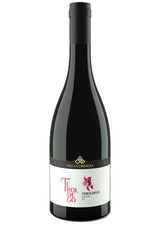Villa Corniole
Villa Corniole, Teroldego, Rotaliano DOC, 2019
Deep ruby red color. The nose is intense, and fruity, with hints of raspberries and currants, broad and fine. The flavor is dry, decisive, fruity, and with soft tannins. It is an ideal wine to accompany typical rich and tasty Trentino dishes, as well as full-bodied first courses (lasagna, pasta ragù, risotto), lamb, game, beef, cured meats, medium or aged cheeses.
Integrated vineyard management: an agricultural approach aimed at protecting vines from diseases, pests, and weather conditions in a sustainable and targeted manner. This method combines various strategies, such as using resistant plants, biological control, rational use of plant protection products, and conscientious management of soil and the surrounding environment. Biological control: Natural predators of vineyard pests, such as predatory insects or bacteria that act against harmful fungi, are favored. Monitoring: Constant monitoring of vine conditions is carried out to intervene promptly in case of problems, reducing the need for massive treatments. Targeted chemical control: If necessary, plant protection products are used in a targeted manner and in accordance with regulations, avoiding waste and reducing environmental impact. Cultural techniques: Agronomic practices such as correct pruning, irrigation management, and balanced fertilization are adopted to promote vine health. This approach requires a deep understanding of the vineyard ecosystem and careful resource management but leads to quality wine production while reducing environmental impact and dependency on chemical substances.
The grapes are harvested manually, selectively, and vinified in red. Fermentation takes place with maceration on the skins for 8-15 days, at a controlled temperature of 26/28°C. Subsequently the wine ages in steel and a small part in barrique. Further refinement in the bottle follows for a few months.
After a period of growth and maturation influenced by extreme weather events, the ideal meteorological conditions favored a late and high-quality grape harvest. The winter of 2018/19 was unusually warm, followed by a dry March and humid April/May with extreme weather phenomena. Therefore, the 2019 harvest started late but produced white wines with freshness, acidity, and elegant structure, especially from higher altitudes. Some red grape varieties faced challenges, with Lagrein being hit by mild hailstorms that reduced yields by up to 80%. Overall, Trentino experienced a 10-15% decrease in the quantity of harvested grapes compared to the average.




